Strategic risk identification in UX design projects: what is it and why you need it
8 Jan 2024
Identifying risks and opportunities is one of the crucial parts of our discovery process – and we are zealous enough to do it twice (image by Midjourney).
Written by Autentika Team
“Having no problems is the biggest problem of all,” Taiichi Ohno, the father of the Toyota Production System, used to say. This is why identifying risks in the UX design project makes sense – even if you, as a client, may be reluctant to do so.
Identifying risks and opportunities is one of the crucial parts of our discovery process – and we are zealous enough to do it twice. However, clients often see it as surprising and welcome it with curiosity and some reservations.
Such a reaction is natural – clients not deeply involved in UX design might have a more product-focused perspective. They may not anticipate the potential challenges that can arise during the design and development phases. They assume that the UX design process is straightforward and doesn’t include any significant obstacles, and they are inherently optimistic about the project’s success.
On the other hand, our experience shows that while some issues can be addressed as they arise, an over-optimistic outlook might downplay the need for a structured risk assessment process at the outset. This, in turn, makes it more challenging to manage costs and timelines and prevent delays and unexpected expenses during development.
The intention here is not to discourage anyone from undertaking a UX design project or starting a digital transformation. As much as we assess risks, we also evaluate chances of success, bonuses, and handicaps that can help us along the way. To make it sound less abstract, we’ll explain what we mean by threats and opportunities and give some examples of what we are talking about.
What is risk identification?
Before diving deeper, let’s briefly define what risk identification means. In UX design projects, it is a part of the discovery process aimed at recognising potential challenges and favourable conditions that can influence project success. It concentrates on factors directly affecting the user experience, such as interface design, usability, and user interaction. It helps the design team recognise potential elements that could impact the project's ultimate success or failure.
This task goes beyond just listing what could go wrong; it involves working on the initiative’s chances and countermeasures for each potential roadblock. The aim is to proactively address and minimise the impact of these risks, ensuring a smoother and more resilient project delivery.

The aim of risk assessment is to proactively address and minimise their impact on the project (image by Midjourney).
Categorising risks
We break down the risks into three main categories:
1) Risks and opportunities directly related to the project.
Risks examples:
- The absence of key decision-makers (due to vacation, sick leave, etc.).
- Uncontrolled expansion of project scope.
- Insufficient resources (human, financial, or technological).
- Miscommunication or conflicting expectations among stakeholders.
All of the above risks can lead to delays and increased project costs.
Opportunities example:
- Leveraging existing internal expertise within the team.
This means, for example, employees with long tenure in the company or sales representatives who have been with the company for years and have vast knowledge about workflows, processes, and clients.
- Comprehensive documentation from previous projects or within the organisation.
Such documents can serve as a valuable reference for understanding past decisions, user feedback, and design considerations.
2) Risks and opportunities that affect the very product we are designing
Risks examples:
-
Planned changes in the company's offerings may affect the shape and function of the product. These risks go beyond the project itself but directly impact what we create.
-
Changes in laws and regulations related to data privacy, security, or accessibility can impact the product's compliance and user experience.
Opportunities example:
- Marketing boost.
The client’s planned heavy investment in marketing the app allows designers to prepare for a significant increase in user activity and proactively test proposed solutions on a larger scale and audience. In turn, this speeds up conclusions and optimises the application.
This insight prompts the need for forward-thinking design adjustments and technological preparations to ensure the application's stability and infrastructure can handle the expected surge, whether it's from a few hundred to potentially hundreds of thousands of users.
Read also: How to build a knowledge system around a new tool?
3) Risks associated with the product launch and its impact on the company
Risks examples:
-
Reducing customer service staff due to automation features of the product.
-
Competitors might respond quickly with similar or superior products, potentially overshadowing the company's launch and eroding its competitive advantage.
-
The inability to scale operations, support, or infrastructure to meet increased demand post-launch can lead to service disruptions and dissatisfied users.
Opportunities examples:
- A new design solution can significantly increase traffic on the client’s e-commerce platform. Consequently, it can contribute to a surge in sales and boost revenue.
Read also: How turning a product into an app employees enjoy fuels business growth
Risk management – more than just a necessity
As you can see, risk identification isn't merely a process – it's a mindset turning challenges into opportunities, setbacks into comebacks, and projects into unforgettable user experiences.
It’s important to say that it is not a typical part of UX designer responsibilities and rarely fits their competencies. Still, our extensive experience positions us to track down and address potential risks, ensuring a smooth journey for our clients. With our input, the client can act according to our recommendations internally with their team or with our help. We are not imposing anything – we simply believe it’s best to be prepared and have a strategic plan for unforeseen events.
If you're interested in delving deeper into our comprehensive process, we invite you to explore this article, where we outline the golden standard for the discovery phase step by step.



